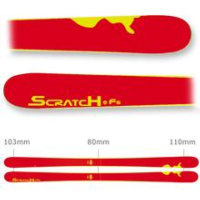Follow this link to read the story from the beginning
This is not really a proper post in the story, just an addendum. It occurred to me that the question of what skis to use comes up so often than I ought to mention my own ski choices as I go along. Those readers who plan to take ski instructor exams will hopefully learn something from my choices (both good and bad). Apologies to the more general readership for throwing in a slightly technical post - I will continue the story with my BASI Ski Instructor Course in Verbier later in the week.
The question of what skis to use has two parts to it - what to use for exams and what to use for teaching. At this point in time I owned two pairs of skis - the original Rossignol Scratches (the red/yellow ones) and a pair of Dynastar 4x4s. The former I believe was Rossignol's first venture into the twin-tip market and the first freestyle ski that I owned. I loved those skis at the time; they were responsive and forgiving and seemed happy to do anything. I found they suited me much better than the Salomon 1080 which I had tried out previously. Also the graphics were slightly risqué but not in an obvious way which I liked. My other skis - the Dynastars - were a long, stiff freeride model. These days they would be considered far to narrow underfoot for an off-piste ski, but this was not long after the days of straight skis so long and thin seemed fine. I did the Trainee Instructor exam on the Scratches and my shadowing hours on Ski Rossendale's rental skis. I used the rental skis partly because it made sense to be on the same skis as the customers but mainly to preserve my own skis from the abrasive plastic matting. At this time the Scratches seemed the ideal ski. I have since learnt that most ski instructor trainers/examiners are not keen on twin-tips and prefer to see candidates on piste oriented skis - more on that in future posts. For the entry level exams though the best advice is probably to use a ski you are comfortable with and not to worry about its pedigree.
Next post - the BASI Instructor Course in Verbier - Part 1

No comments:
Post a Comment